Update January 2025: This promo is back, but at 2% of asset transferred instead of the old 3%. Still a good deal, and many of the details below may be useful.
Update May 2024: This promo is now over. I ended up moving over my spouse’s IRA as well, for another ~$8,000 on ~$300,000 transferred. Total is about $16,000 in bonuses for ~$600,000 transferred.
Update 4/24/24: At some point within the last week, Robinhood has changed their language to say that if as long as you initiate your IRA transfer by 4/30 as a Gold member, you will receive the 3% match.
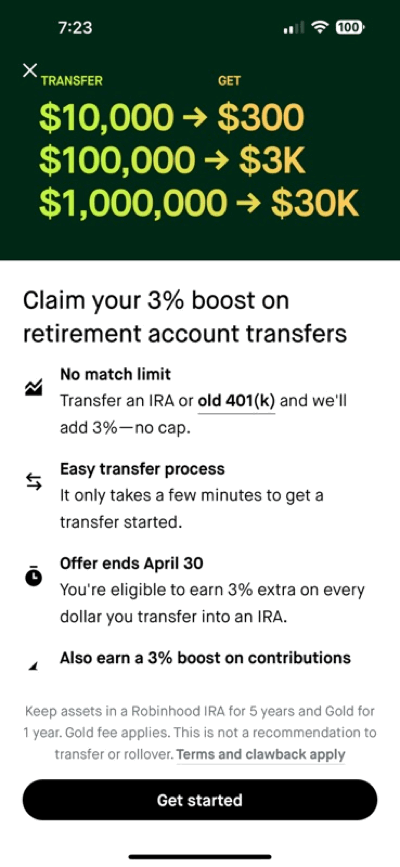
Update: My transfer is complete after 3 business days. $7,885 bonus posted. Robinhood offers an improved 3% match on IRA contributions if you subscribe to their Gold membership, which costs $5 a month. Through 4/30/24, you can also get a 3% match on IRA transfers and 401k/403b/457/401a rollovers. Please start with my initial 3% IRA Match overview, the Robinhood FAQ, and Robinhood Terms & Conditions [pdf]. After doing hours of additional research, this is a follow-up post with a lot of details for other folks that also like to cover all the bases.
I’m have just completed my own transfer, and here’s the full walkthrough:
- Open a Robinhood brokerage account (done years ago) and put some money inside. If you haven’t opened one before, here is my referral link. It is overwhelmingly likely you’ll only get $5 of stock (as will I), but there is a very tiny chance you’ll get $200.
- Signed up for Robinhood Gold (first 30-days free, then $5 or $6.99/month). It is important you do this first, before the transfer.
- Opened a Roth IRA account on 4/10 (leave empty). I declined Securities Lending, as it removes SIPC protection.
- Requested a transfer from Vanguard Roth IRA on 4/11 (all Vanguard ETFs inside).
- Received email “Roth IRA account transfer request has been accepted’ on 4/15.
- Received email “Good news! Your Roth IRA account transfer was completed” very late 4/16 (technically 4/17). So it took 3-4 business days, faster than the estimated 5-7 business day.
- Robinhood credited the 3% immediately upfront (~$7,885). To keep it, I need to keep the transferred balance + bonus amount in the IRA for 5 years. I also need to keep paying for Robinhood Gold for a full year past the bonus paid date. I plan to turn on automatic dividend reinvestment and not touch it for 5 years.
- I don’t plan on making future IRA contributions into Robinhood, as I don’t want to keep my IRA there past 5 years. (Let’s say you put in $100,000 in Year 1 and then $7,000 in Year 2, Year 3, Year 4, Year 5. If you attempt to take out any amount at all in Year 6, how can you designate that money as part of the “old” $100,000 and not any of the more recent $7,000 contributions? It would just seem like you’re taking out part of the $7,000 contribution from Year 5 and thus lose that match, right?)
Here are some screenshots from the process:
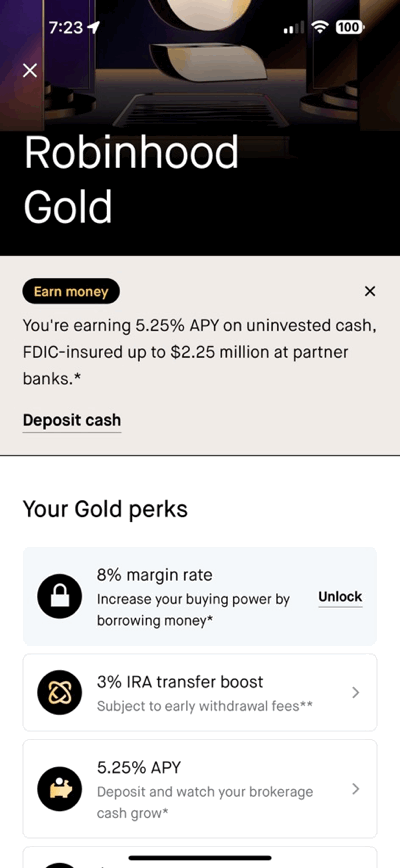
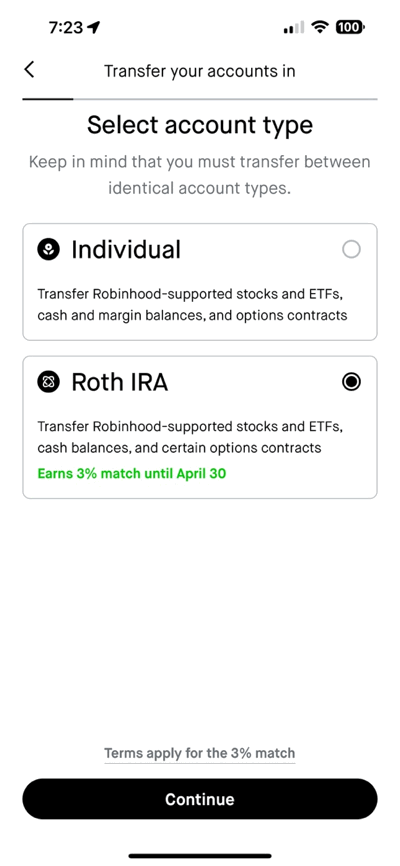
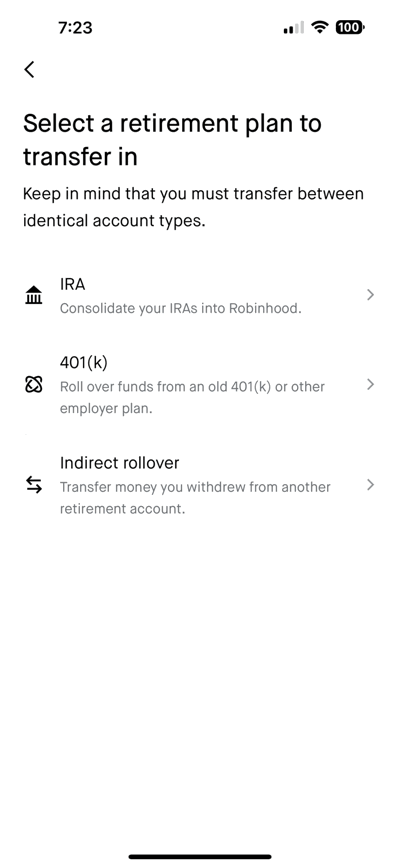
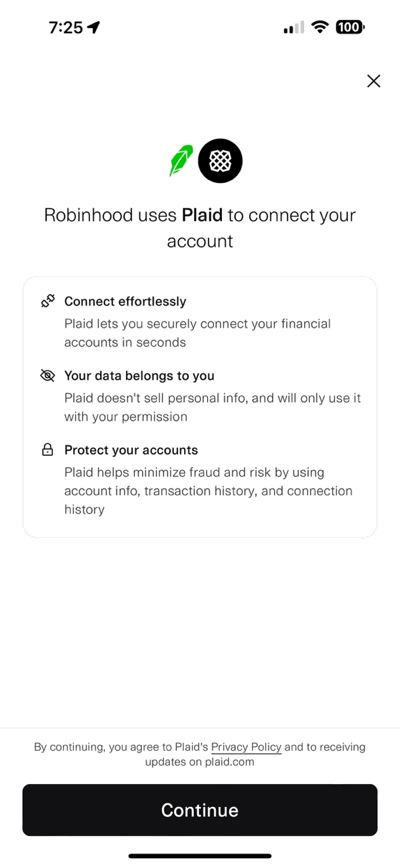
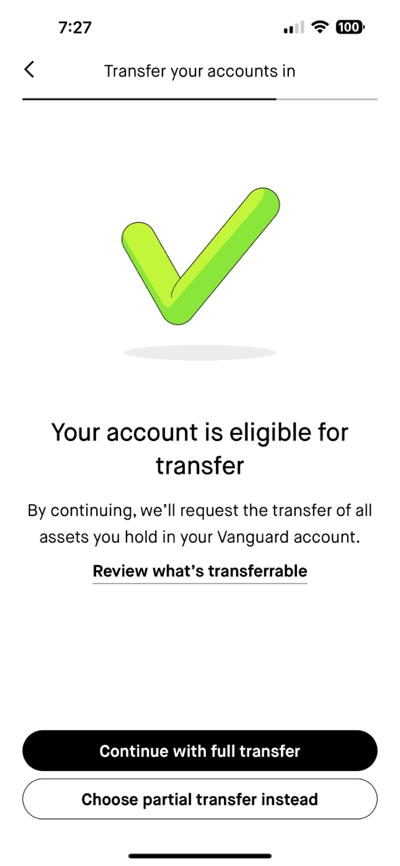
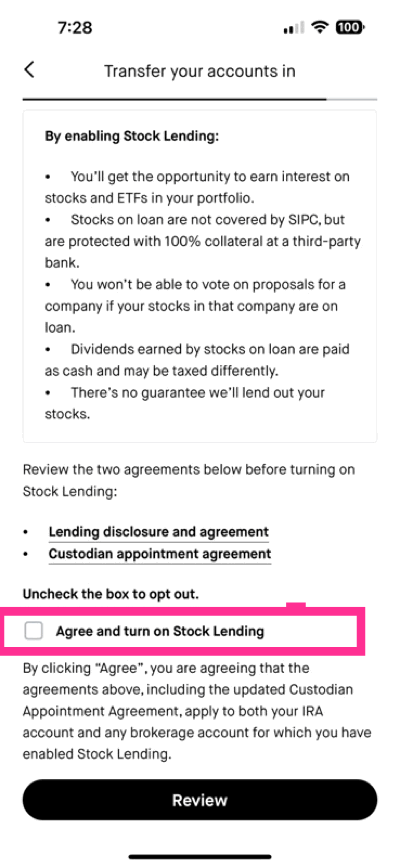
Robinhood doesn’t allow all asset types, so you can’t own mutual funds, individual bonds, and closed-end funds. Robinhood is not a full-featured brokerage firm. Here is the full list of what is and isn’t allowed. They support the following:
- U.S. exchange-listed stocks and ETFs
- Options contracts for U.S. Exchange-Listed Stocks and ETFs
- ADRs for over 650 globally-listed companies
This means that if you want to move your balance over to Robinhood, you will have to sell any mutual funds (or convert them to ETFs), individual bonds, brokered CDs, and so on. I converted my Vanguard mutual funds to ETFs, and it took 1-2 business days.
SIPC insurance limits and excess insurance. Robinhood is a member of the Securities Investor Protection Corporation (SIPC), which steps if a broker fails. Robinhood has also purchased additional excess SIPC insurance on the private market. From the Robinhood site:
Robinhood Financial LLC and Robinhood Securities, LLC are both members of SIPC, which protects securities for customers of its members up to $500,000 (including $250,000 for claims for cash). Explanatory brochure available upon request or at www.sipc.org.
We’ve purchased an additional insurance policy for Robinhood Markets, Inc., Robinhood Financial LLC, and Robinhood Securities, LLC to supplement SIPC protection. The additional insurance becomes available to customers in the event that SIPC limits are exhausted. This additional insurance policy provides protection for securities and cash up to an aggregate of $1 billion, and is limited to a combined return to any customer of $50 million in securities, including $1.9 million in cash. Similar to SIPC protection, this additional insurance doesn’t protect against a loss in the market value of securities.
From SIPC.org::
SIPC protects against the loss of cash and securities – such as stocks and bonds – held by a customer at a financially-troubled SIPC-member brokerage firm. The limit of SIPC protection is $500,000, which includes a $250,000 limit for cash.
Is SIPC a U.S. Government Agency?
No. SIPC is not an agency or establishment of the United States Government. SIPC is a non-profit membership corporation created under the Securities Investor Protection Act.
My brokerage firm has excess SIPC insurance. How does that work?
Excess SIPC insurance is insurance provided by a private insurer and not by SIPC. The insurance is intended to protect brokerage customers against the risk that customers will not recover all of their cash and securities in the proceeding under the Securities Investor Protection Act (SIPA). Under many of these policies, customer eligibility for recovery is not determined until after the SIPA liquidation of the customer’s brokerage firm has concluded and the amount of the customer’s recovery in that proceeding has been established.
Some people have concerns that Robinhood is a smaller company with a history of questionable judgment and violating securities regulations. Robinhood holds the current record for highest FINRA fine ever. As a result, you may choose to limit the amount transferred to Robinhood to under $500,000 in assets (and $250,000 cash) per eligible account type. Here are the different “capacities”. For example, you could have an individual taxable account, a traditional IRA, and a Roth IRA at Robinhood and each one would have $500,000 in coverage. I will be staying under these limits as well, but my IRA balance simply isn’t that big anyway.
Note that if you opt-in (or don’t opt-out) to Stock Lending during the account transfer or account opening process, any securities that are loaned out are no longer protected by the SIPC. This is usually offset by a promise of 100% collateral, but that assumes trust that Robinhood will post that collateral. See Gamestop short squeeze for a very recent example of Robinhood… not posting enough collateral. Therefore, I also don’t recommend Stock Lending with Robinhood.
Robinhood limitations on beneficiaries. Robinhood only allows a primary beneficiary who is an adult. That means no trusts, no minors, and no “per stirpes” instructions. See article.
Whom can I designate as my beneficiary?
To be eligible as a TOD or IRA beneficiary, the individual must be a person who is at least 18 years old, a US Citizen, or otherwise be legally permitted to open a Robinhood account.
The Robinhood Gold IRA Deposit Match counts as interest earned inside your IRA. From the official Terms and Conditions:
Robinhood processes and treats the Robinhood Gold IRA Deposit Match as interest earned by the IRA account for tax reporting purposes. The interest amount is based on a percentage of contributions made into the IRA Account. The interest earned by the IRA account will not be subject to, or impact, the maximum annual dollar contribution limit or the maximum annual deductible amount. Please note that the Robinhood Gold IRA Deposit Match may be taxable income for conversions of a non-deductible IRA contribution to a Roth IRA. Robinhood does not provide tax advice. You are encouraged to consult with your tax professional about appropriate tax reporting and treatment relating to this bonus award and the deposit of the bonus award in your account. Any taxes resulting from the bonus award are your responsibility.
From the FAQ:
Does the IRA match count toward my annual IRA contribution limit?
No. The IRA match counts as interest income in your IRA and doesn’t count toward your annual IRA contribution limit.How is the IRA match treated for tax reporting purposes?
The IRA match is treated as interest income in your IRA. We won’t deliver a 1099-INT due to the tax status of IRAs.
This important factor makes the effective value higher than the usual cash bonus that is taxable income. The amount gets to keep growing inside your Roth IRA, tax-free.
Robinhood will also reimburse your transfer fees up to $75 if you transfer at least $7,500 worth of assets. After the transfer is completed, you must contact then via the live chat function and they will reimburse you after you upload a screenshot of the fee charged.
When you transfer out eventually, Robinhood does charge a $100 Outgoing ACAT fee. Ideally, there will be another broker to reimburse that fee in the future, but who knows. Here is their full fee schedule [pdf].
Customer service tips. Robinhood does not have a traditional phone number to reach customer service. You have to go the help section, search for a topic, and then look for the “Contact Us” button at the bottom of the page (presumably after you have read the canned answer and still need help). Then you can either have a Live Chat or request a Callback where they will call you back on the phone at a later time.
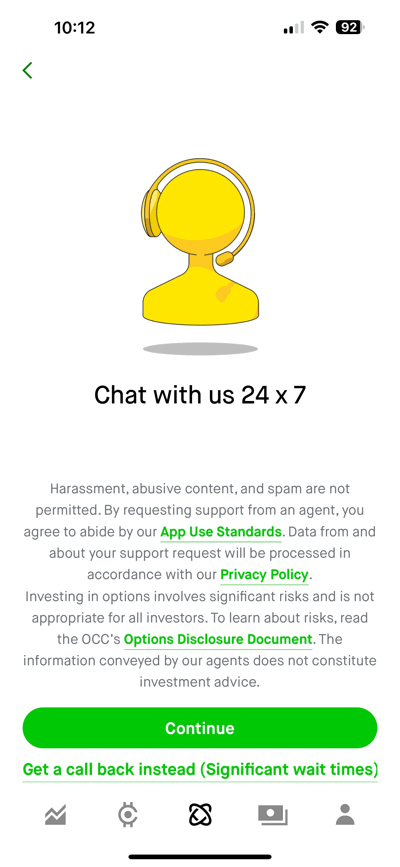
Security and Privacy tips. To access these settings on the iPhone app, click on the head/body icon on the bottom right, then the three lines icon on the top left, and then “Security and privacy”. On the plus side, Robinhood supports a variety of 2FA options: SMS, Device passkeys, and Authenticator apps. Scroll down further and you can also opt out of their data sharing.
The deadline is April 30th, and the terms state the transfer has to be “initiated and completed” by that date. As of right now, there’s still a decent buffer as it takes about a week for most IRA transfers. For those with large IRAs, this can be a very significant bonus. You may have reservations about moving your assets to Robinhood, which is certainly understandable. I hope this helps you make a more informed decision for your own situation.
 The Best Credit Card Bonus Offers – 2025
The Best Credit Card Bonus Offers – 2025 Big List of Free Stocks from Brokerage Apps
Big List of Free Stocks from Brokerage Apps Best Interest Rates on Cash - 2025
Best Interest Rates on Cash - 2025 Free Credit Scores x 3 + Free Credit Monitoring
Free Credit Scores x 3 + Free Credit Monitoring Best No Fee 0% APR Balance Transfer Offers
Best No Fee 0% APR Balance Transfer Offers Little-Known Cellular Data Plans That Can Save Big Money
Little-Known Cellular Data Plans That Can Save Big Money How To Haggle Your Cable or Direct TV Bill
How To Haggle Your Cable or Direct TV Bill Big List of Free Consumer Data Reports (Credit, Rent, Work)
Big List of Free Consumer Data Reports (Credit, Rent, Work)
Not sure what you mean about the 5 year rule. It’s 5 years from ANY IRA, not this one. You’re good…
I am saying that the ongoing 3% match on IRA contributions (with 5-year earnout) is a clever way for them to nudge you to keep all your IRA balances with them. Every year, a chunk of your IRA will be locked up for another 5 years. Whenever you contribute $7,000 and try to take out anything in the next 5 years, they can just say that is from your most recently matched $7,000 contribution.
Ah ok got it. Sorry – I thought you referred to the IRA must be open 5 years rule.
Ah I see. Nah not that. I have no plans to take any funds out of the IRA early.
“I don’t plan on making future IRA contributions into Robinhood, as that will reset the 5-year minimum hold time” – I’m pretty sure that is not the case. If you contribute in the future that new Robinhood match would be subject to the new 5-year rule, not this transfer that you’re currently doing. Also, I’ve transferred from both Vanguard and Fidelity, took 3 business days for Vanguard and 2 business days for Fidelity. They do say that it has to settle by 4/30 not just be initiated.
I understand that is technically not the case, but let’s say you put in $100,000 in Year 1 and then $7,000 in Year 2, Year 3, Year 4, Year 5. If you attempt to take out any amount in Year 6, how can you designate that money as part of the “old” $100,000 and not any of the more recent $7,000 contributions?
Edit: Thanks, I found the completed language for the deadline.
https://robinhood.com/us/en/support/articles/ira-gold-match-2024/
Look at “Your IRA or 401(k) transfer must settle into your Robinhood IRA during the promotion period of January 17, 2024 through April 30, 2024.”
Regarding withdrawals see https://robinhood.com/us/en/support/articles/ira-match-faq/, “Do I get to keep the IRA match if I withdraw money from my IRA?” question and answer. If total balance after 5 years is > total transferred + contributed then it looks like it’s safe to withdraw, but if it’s not they could apply whatever rule, I don’t see it spelled out anywhere yet. I have VNQ in rIRA there which could easily stay down for a long time and fluctuates a lot. So, it may make sense not to contribute next year if they don’t clarify the rules.
Did they provide $75 reimbursements for both transfers (assuming Fido/Vanguard are charging transfer fees). Thinking of transferring from BofA and Vanguard.
Neither Vanguard nor Fidelity charge transfer out fees.
vanguard has fees in their schedule
These were added very recently (after Sergei’s comment) and will go into effect 7/1/24.
https://www.mymoneyblog.com/vanguard-adds-new-account-closure-and-outgoing-transfer-fee.html
Something does not smell quite right. I hope this works out for those willing to risk it. Professional financial economist and historian of financial panics and crashes here.
Trondex, I am also a little worried that I may be setting myself up for future frustration by transferring assets to Robinhood, and yet I am still tempted. I don’t see how they ever make their money back on a customer with these kinds of generous payouts, and that makes me worry a bit about the long-term viability of the company. Can you elaborate a bit on your thoughts?
Thirty-seven pages of information can be found here: https://www.bogleheads.org/forum/viewtopic.php?t=410277 .
The summary, “Robinhood Securities, LLC are members of the Securities Investor Protection Corporation (SIPC), which protects customer securities up to $500,000, including $250,000 for cash. This coverage is triggered if Robinhood maligns or faces financial instability.”
Keep less than $500,000, or maybe a little less, so gains still fall under SIPC. Also, have some solid ETFs that can be easily transferred to another broker if needed.
Robinhood made the process ridiculously easy. I rebalanced my IRA at Fidelity this week and combined VTI and VXUS to purchase VT. Once the fund settles, I will transfer my IRA and use two ETFs, VT and BND for the next five years.
Looking to transfer my Vanguard Roth to Robinhood, but I am holding Vanguard Target Funds. What’s the best alternative in ETFs?
Vanguard target funds can be replicated with just 3 Vanguard ETFs: VTI (US stocks), VXUS (non-US stocks), and BND (bonds). Or, as simple as VT (world stocks) and BND. Use percentages that your target fund is using if you want to match as closely as possible.
Blackrock now has low cost ETF target date retirement funds available as an option. You may want to consider those to automate your decreasing risk with age.
Thank you for the post. It answers a lot of my questions.
A follow-up question on the 5-year rule.
Since you already have a Roth account and assuming you did make the first contribution to the old Roth account, according to Investopedia, contribution to a new account would not reset the 5-year clock:
“A note for multiple account owners: The five-year clock starts with your first contribution to any Roth IRA—not necessarily the one from which you’re withdrawing funds. Once you satisfy the five-year requirement for one Roth IRA, you’re done.”
Is the Investopedia interpretation right? Your thoughts?
I apologize, nothing I wrote above is about the 5-year rule for Roth IRAs in terms of withdrawing without IRS penalties. It’s only about the 5-year hold requirement mandated by Robinhood so that they won’t claw back the bonus cash they paid you. I have rewritten the text to be more clear.
After your transfer was accepted was it an immediate swap? I mean did your equities sell and buy at the same price? What I worry about with transfers is time out of market. You could lose a bunch of money if there is a multi day period between the sale and purchase if the market shoots up. On the other hand you could gain if it goes down.
One time I transferred from a 401k to an IRA and my money was in limbo for a full week. I ended up losing about a thousand in gains.
I performed an in-kind IRA to IRA transfer, so there was zero time out of the market. If you had 100 shares of an ETFs, you’ll end up with 100 shares of that same ETF.
Yes, if you have a 401k rollover, they may need to cash out and there may be time out of the market. I don’t know if that’s avoidable, no matter what where you roll over to, however. At least this will give you a 3% buffer, and like you said who knows, you might actually be able to buy in at a lower price.
If possible, you should see if they will perform an in-kind rollover to an in-house IRA. For example, Fidelity 401k to Fidelity IRA. Then perform an IRA to IRA transfer to Robinhood.
Thank you for the article!
I did this transfer a month or so ago, and have had mostly positive experience, with some quirks.
But after reading your article I realized a huge shortcoming – inability to designate a trust as beneficiary? Is that truly the case? I tried to chat with them after I read it and unfortunately the rep was terrible – she did not understand the difference between a trust and a trusted person. I asked to escalate and really hope they have some way to designate a trust beneficiary, but if not, it’s a huge bummer.
Nope, no trusts. Basically the beneficiary has to be able to open an account at Robinhood.
Unless something changed very recently, Robinhood doesn’t even allow joint taxable brokerage accounts! (This doesn’t matter for IRAs, of course, but it does show how limited they are in many ways.)
Wow, that is really no good, and I don’t even understand what the trouble is. They just need long enough field in the database to record the name of a beneficiary.
I guess I’ll have to set up my wife as a direct beneficiary, which is not good at all in case we both pass at the same time. And I can’t even set up my child as a contingent beneficiary due to age restriction, not to mention a trust allows assignment of proper trustee, setting up a distribution schedule, etc.
Jonathan, thanks for posting details about transferring to Robinhood. Quick question, you mentioned that $7,885 bonus is deposited into your IRA account. How does bonus $$$ account for IRS purposes. Does it count towards FY 2024 IRA contributions? or these kind of bonuses will not count towards IRA contributions – If so, what are these deposits tagged as. Thanks in advance!
Please see post, it’s all there.
Thanks for this detailed write up! Bank link through plaid stopped me in my tracks, not going to share all my current & future transactions with Robinhood. Found a workaround to plaid, but not sure it’s worth it for few hundred dollars net anyways.
There is $1000 interest-free margin included with Gold. Do you plan to utilize it?
Hi, probably a stupid question, I’m planning to transfer over a Roth. My income this year will be over the limit to contributing to Roth. Since I have to open a new Roth account with Robinhood first to do the transfer, this would not count as contributing to Roth right? I’m asking because when I was opening the account, normal warnings shows up (income limit, etc..), so that got me worried a little bit. Thanks
No, IRA to IRA transfers between custodians don’t count as contributions.
ok- I bit (friday am 4/19 1130EDT) 🙂
Two q’s
1.) I tried to transfer 2 separate fidelity roth IRAs and it rejected my second request saying it was a duplicate. 2 different account #s though. I assume this is a glitch and if I try later or another day it will go through? One has 90k and is listed as processing. One has 20k and is the one that failed – as a duplicate.
2.) Does a small balance of $10 in VMRXX (vanguard federal cash reserve money market) mean that a vanguard transfer might get rejected? All else in that roth is are vanguard etfs of approx ~100k? thanks – late bird trying to get the worm!
1) I agree, I’d probably try them in series, rather than parallel. You should have time.
2) Mutual funds that are the cash sweep are okay, they will just get liquidated and move over as cash.
Good luck!
ty!
will let others know my experience
People at DoC confirmed that you have to wait for 1st transfer to be done before asking for 2nd from the same broker.
Great ! Thanks
Btw what’s DoC
Sorry if I missed it, but can you show the source of this 4/24 update about the transfer only needing to be initiated and not initiated and completed by 4/30? I have their support also saying it only needs to be initiated, but I fear this is where I’ll get bitten anyway since the clawback verbiage in the T&C doc still says initiated and completed (on 4/25 morning). Thanks!
I successfully transferred my traditional IRA and now am moving on to my Roth. The wrinkle is that I am considering taking some distributions from the Roth over the next couple of years (tax/penalty free). From my reading it seems that the 3% clawback penalty would only apply to the funds removed and may not apply at all if there’s enough overall appreciation in value. Is there any reason I should hold back some of the funds at ETrade for my near-term future distribution? Just making sure I’m not missing something.
Hi Jonathan. Thanks for the article. I’m currently in the process of transferring a couple of accounts from Schwab to Robinhood. These transfers won’t be completed by 4/30, which I’ve been told by Robinhood’s customer service reps through chat that I’ll still get the 3% match since I’ve initiated the process (I’m still skeptical) I see from the update you posted above that Robinhood has changed the language in the offer, but the language I’m reading continues to state that the funds must settle by the 30th in order to qualify. I’m wondering if you could provide a link to the revisions you saw. Thank you much.
They changed various language on the actual website and app, but not the official terms and conditions PDF. I think they might have changed it again in since I last looked because it reads different today (welcome to Robinhood!). So I’m afraid I can’t offer you much, although it does seem that the customer service reps are consistent across the fact that all transfers imitated by 4/30 will be honored. My hunch is that you will be okay.
This is, IMO, the best ‘free’ deal I have ever participated in – and I found it detailed here first (I saw it elsewhere but no details – just some sort of banner ad if I recall).
I had extreme concerns about RH given all of their bad press – most of it well deserved.
But…
3% completely tax free forever is extremely hard to come by.
My transfer for myself and my wife are almost fully complete. Just a 30k roth from fidelity that needs to come over (initiated 4/26 – listed as in process from the fido side) some fractional shares – which I think will arrive as cash and tiny bits of cash in sweep accounts that will presumably settle over the next week.
As of this moment my spouse and I have had a total of just under 16k in 3% match already credited. By the end of the whole thing it will be just under $17k.
That’s more than 1 year of extra Roth IRA contribution (7k+7k = 14k) than I could get even as we always max out all of our backdoor and mega backdoor roth contributions.
All of the other deals I do – unless they are credit cards points deals – are taxed at roughly 40% (state+fed), and of course the earnings on gains are taxed as well at the applicable rates depending on where the funds ‘go.’
I just wish I had a total of just under 900k to have had to trasfer (I won’t go over SIPC at RH – maybe they are too big to fail, but I know from past press and experience of others they aren’t too big to be a complete mess in a volatile market). The only downer is the beneficiary issue. That is definitely an annoyance – if they fix it I might consider sticking with RH for 3% ($210) per year on my yearly contribution.
Thanks J&MMB!
I moved over my old Roth and my Traditional and quickly got the bonus. What can I do with the bonus now? I’m over the income limit for the Roth so do I have to have the cash just sit there?
The bonus counts as a capital gain/interest within the tax-sheltered IRA. You can invest it immediately.